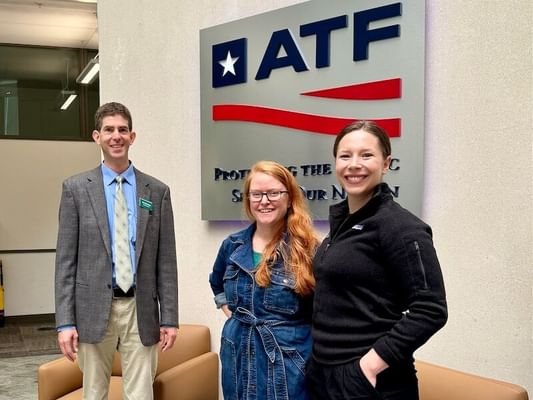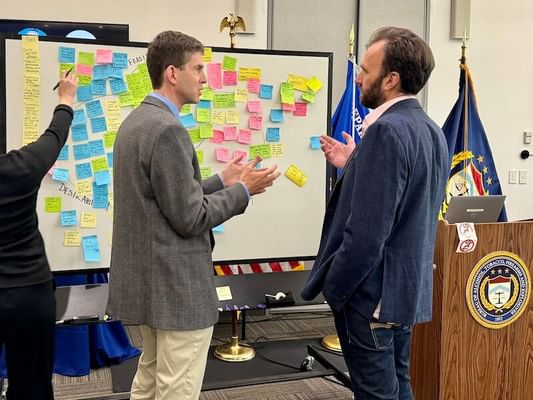- Undergraduate
Bachelor's Degrees
Bachelor of ArtsBachelor of EngineeringDual-Degree ProgramUndergraduate AdmissionsUndergraduate Experience
- Graduate
Graduate Experience
- Research
- Entrepreneurship
- Community
- About
-
Search
All Thayer News


Dartmouth Engineering Applies Human-Centered Design to the Challenge of Illegal 3D-Printing of Machinegun Conversion Devices
Sep 30, 2024
A piece of 3D-printed plastic that can turn a handgun or rifle into a fully automatic machinegun is now found in the majority of illegal guns seized in firearm trafficking cases nationwide. These machinegun conversion devices, or MCDs, have been notoriously difficult for law enforcement to track and regulate.

Dartmouth Engineering's Solomon Diamond, Emily Monroe, and Paula Olson attended DOJ's recent convening on combating the production of unlawful machinegun conversion devices. (Photo by Duann Scott)
A Dartmouth Engineering team is contributing a different kind of tool—human-centered design and design thinking—to the White House's latest efforts to combat the growing threats of MCDs and unserialized, 3D-printed firearms.
The Design Initiative at Dartmouth (DIAD) and the US Department of Justice (DOJ), now tasked by President Biden through executive order to develop solutions to 3D-printed MCDs, are continuing their ongoing partnership and leveraging the design thinking process to address an increasingly complex and deadly problem.
"DIAD is facilitating this academic-industry-government partnership to study, develop and deploy solutions that are feasible, desirable, and economically viable," said Solomon Diamond, associate professor of engineering and co-director of DIAD.
Proposed solutions to complex, multi-layered problems are often unsuccessful or fail to adequately address the problem for everyone. Human-centered design methodology considers human needs and potential impact at each step of the problem-solving process. Often used in product or engineering design, the methodology can also be used to improve policies or systems.
In early September, DOJ convened members of the additive manufacturing industry, law enforcement, and academia—which included Diamond, Paula Olson, senior program manager for DIAD, and Emily Monroe, director of Dartmouth's Cook Engineering Design Center (CEDC)—to help move the project from an idea into a true collaboration among the 3D printing industry's software, hardware, policy, research, and trade groups.
"Raising awareness about the problem of 3D-printed machinegun parts is critical at this time," said Monroe. "They're small, cheap, easy to install, and can be 3D-printed in less than 30 minutes for as little as 40 cents." The Bureau of Alcohol, Tobacco, Firearms and Explosives (ATF) reported that from 2017 through 2021, the bureau had recovered 5,454 MCDs, a 570 percent increase over the previous five-year period.

Professor Sol Diamond leads a design-thinking brainstorming exercise. (Photo by Emily Monroe)
The collaboration began when ATF Director Steven Dettelbach '88 visited Dartmouth in February to give a talk about gun violence at the Nelson A. Rockefeller Center for Public Policy and the Social Sciences. During the visit, Dettelbach reached out to Alexis Abramson, dean of Thayer School of Engineering, for help. Abramson invited Diamond and Monroe to a dinner with Dettelbach's team.
Diamond has extensive expertise in 3D printing, including the steps involved in processing designs from their digital representations to physical parts. Monroe is a licensed professional engineer in mechanical design and manufacturing and a firearms expert. Diamond and Monroe recruited Olson, an experienced facilitator in design-thinking and problem-solving.
Since February, the Dartmouth team has met regularly with ATF representatives and collaboratively built a framework, defined pain points, and began preliminary tests of potential solutions that could incentivize a reduction in 3D-printed machinegun components.
"[The Dartmouth team] facilitated an engaging roundtable discussion between national leaders in law enforcement, the additive manufacturing industry, and the research community," said Dettelbach. "That dialogue yielded numerous ideas for future actions to stem the printing of these illegal and dangerous devices. Their efforts are making a meaningful impact in protecting the lives of Americans."
Through the design-thinking process, the team has reframed the problem as an opportunity to enhance social, educational, and economic value of 3D printing in homes, schools, and makerspaces. They're drawing inspiration from the filters that block printing of currency on inkjet printers and the emergence of desktop publishing, as well as the evolution of digital music from illegal file sharing on Napster to the streaming music services.
The envisioned next step is to formalize the academic-industry-government partnership to study, develop, and deploy solutions that are technically feasible and desirable by 3D-printer users, while also economically viable for the companies that produce 3D printers, software solutions, and content creators.
For contacts and other media information visit our Media Resources page.
